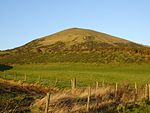Newburn, Fife
Newburn is a civil parish in the County of Fife in Scotland. It is located on the north coast of the Firth of Forth and bounded by the parishes of Kilconquhar and Largo. It was originally a rural parish with no major settlement, but with the development of Leven as a seaside resort in the late 19th century, the population of the parish grew considerably. According to an 1857 description, "The parish is bounded on the north & east by Kilconquhar, on the south by Largo Bay and on the west by Largo. It is 3.5 miles (5.6 km) from north to south and 2 miles (3.2 km) in breadth. Its area is 2,400 acres (9.7 km2), all under cultivation except 350 under pasture and 130 under wood. The land surface near the shore is sandy, forming extensive links which are kept in pasture. The land ascends from the shore to the northwards, reaching its greatest height at Gilston. The soil, with the exception of the links, is very fertile. The rent of land averages £2-12-0 per acre. The parish schoolmaster's salary is £30, plus £14 of fees, besides which there is an allowance for teaching a certain number of Poor children, from a fund left by John Wood of Orkie in 1659. There is 1 public house in the parish; sobriety and industry prevail. The nearest market towns are Colinsburgh and Largo. Balchristie is the only hamlet in the parish, containing a few houses".
Excerpt from the Wikipedia article Newburn, Fife (License: CC BY-SA 3.0, Authors).Newburn, Fife
A917,
Geographical coordinates (GPS) Address Nearby Places Show on map
Geographical coordinates (GPS)
| Latitude | Longitude |
|---|---|
| N 56.224 ° | E -2.898 ° |
Address
Lahill House
A917
KY8 6JD
Scotland, United Kingdom
Open on Google Maps









